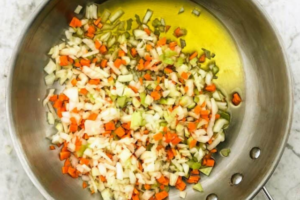Pomarola

Pomarola is a beloved Italian tomato sauce that embodies the essence of Mediterranean cuisine. This simple yet flavorful sauce is a staple in Italian kitchens, known for its versatility and ability to complement a wide variety of pasta dishes. Let’s delve into the history, heritage, development, variants, and pasta pairings of Pomarola.
History and Heritage
The history of Pomarola can be traced back to the traditional Italian practice of preserving summer tomatoes for use throughout the year. In Italian, “Pomodoro” means tomato, and “Pomarola” refers to a sauce made primarily with tomatoes.
The sauce likely originated in southern Italy, where tomatoes are abundant and central to the culinary culture. Pomarola was originally a way for Italian families to make use of ripe tomatoes during the harvest season and preserve their flavors for the colder months.
Development and Ingredients
The key ingredients of Pomarola include fresh tomatoes, onions, garlic, olive oil, basil, salt, and sometimes a pinch of sugar to balance the acidity of the tomatoes. The sauce is made by sautéing onions and garlic in olive oil until soft and translucent, then adding crushed tomatoes and simmering until the sauce thickens and the flavors meld together.
Fresh basil is typically added at the end to brighten the sauce and infuse it with aromatic freshness. Pomarola is characterized by its bright red color, rich tomato flavor, and smooth consistency.
Variants and Adaptations
While the classic recipe for Pomarola remains popular, there are variations and adaptations that reflect regional preferences and creative interpretations. Some versions of the sauce may include additional ingredients such as carrots, celery, bell peppers, or red wine for added depth of flavor.
In modern interpretations, chefs and home cooks may experiment with different types of tomatoes, herbs, and spices to create unique variations of Pomarola while staying true to its essence as a tomato-based sauce.
Usage and Pasta Pairings
Pomarola is traditionally used with a wide range of pasta shapes that can hold the sauce and complement its robust flavors. Some popular pasta shapes that pair well with Pomarola include:
- Spaghetti: A classic pasta shape that allows the sauce to coat each strand evenly.
- Penne: Short, tube-shaped pasta that captures the chunks of tomatoes and sauce.
- Fusilli: Spiral-shaped pasta that holds the sauce well and provides a satisfying texture.
These pasta shapes are ideal for enjoying Pomarola, ensuring that each bite is a perfect balance of pasta and sauce.
Cultural Significance
Pomarola holds cultural significance in Italian cuisine, representing the simplicity and freshness of Mediterranean cooking. It is often enjoyed year-round as a comforting and versatile sauce that can be used in pasta dishes, pizza toppings, or as a base for other Italian recipes.
Conclusion
In conclusion, Pomarola is a classic Italian tomato sauce that celebrates the vibrant flavors of ripe tomatoes and fresh herbs. With its rich taste and versatile applications, Pomarola is a staple in Italian households and a testament to the culinary heritage of Italy. Experience the delicious simplicity of Pomarola and elevate your pasta dishes with this timeless tomato sauce.

Ingredients
Method
- Heat the olive oil in a large saucepan over medium heat.
- Add the chopped onion, garlic, celery, and carrot to the pan. Cook forabout 5-7 minutes until the vegetables are soft and translucent.

- Stir in the tomato paste and cook for another 1-2 minutes.
- Add the chopped tomatoes to the pan along with salt and pepper to taste. Stir well to combine.
- Lower the heat to medium-low and simmer the sauce for about 20-25minutes, stirring occasionally, until it thickens and the flavors meld together,
- Add chopped fresh basil leaves to the sauce during the last few minutesof cooking. Adjust seasoning if needed.
- Meanwhile, bring a large pot of salted water to a boil.
- Add the pasta and cook according to package instructions until al dente.
- Reserve about 1 cup (250ml) of pasta cooking water, then drain the pasta.
- Add the drained pasta to the pot with the Pomarola sauce.
- Toss gently to coat the pasta evenly with the sauce. If the sauce is toothick, add some of the reserved pasta cooking water to loosen it.
- Divide the pasta with Pomarola sauce among serving plates or bowls.
- Serve hot, optionally topped with grated Parmesan cheese and additionalfresh basil leaves.
- Enjoy this comforting and flavorful Italian pasta dish!
